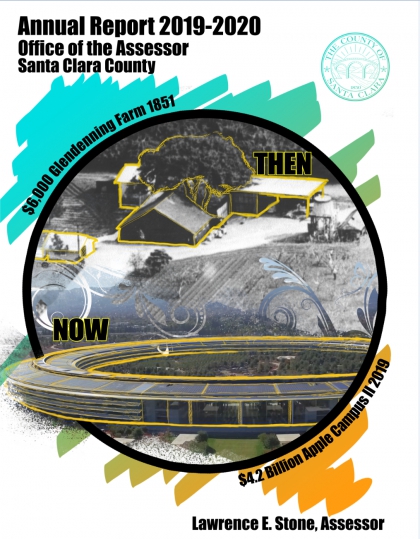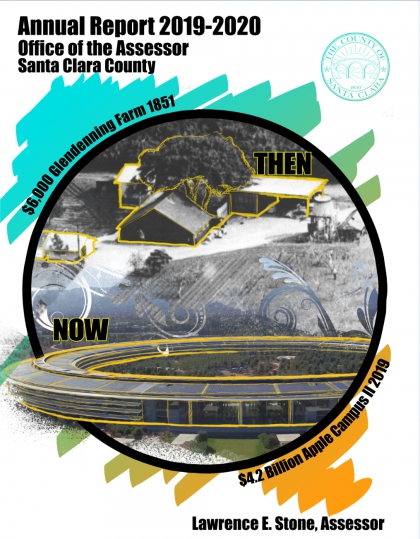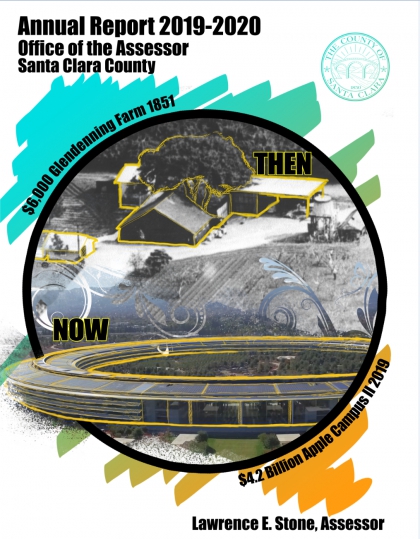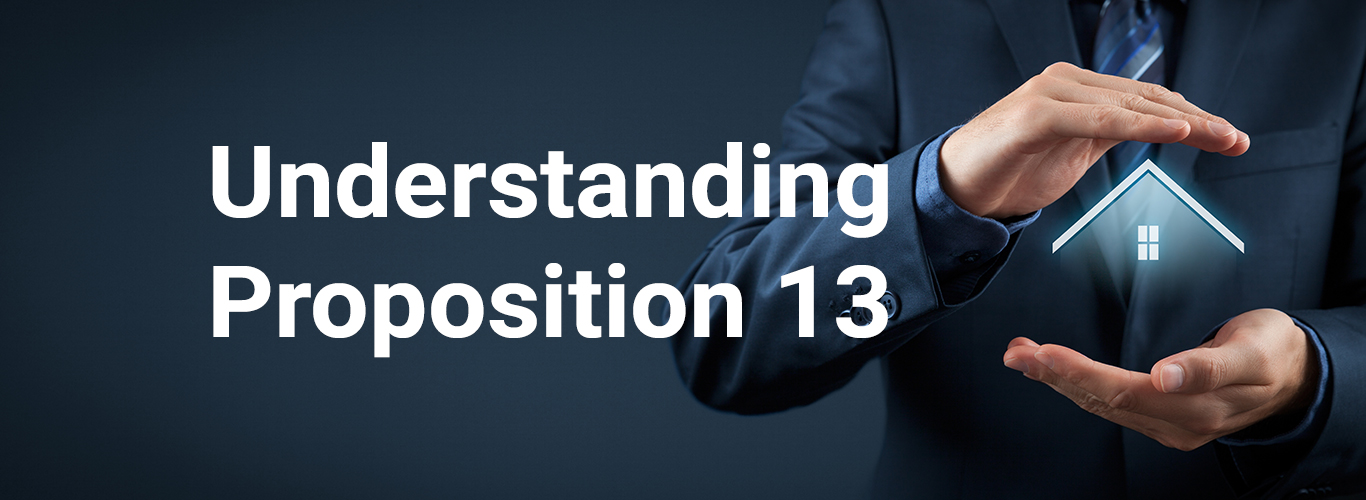

Below are links to each of the above articles:
South Valley Magazine:
San Jose Mercury News:
https://www.mercurynews.com/2020/06/04/coronavirus-lockdowns-no-match-for-bay-area-home-buyers
Barrons
https://www.barrons.com/articles/sellersparticularly-in-the-higher-endreturn-to-market-01591021701
San Francisco Chronicle
Silicon Valley/San Jose Business Journal
https://www.bizjournals.com/sanjose/news/2020/05/28/san-jose-home-sales-increasing-covid-impact.html
San Jose Spotlight
https://sanjosespotlight.com/in-pricey-silicon-valley-homebuyer-perceptions-not-prices-have-changed/
Bloomberg
On July 1, 2020, County Assessor Larry Stone delivered the annual assessment roll to the Santa Clara County Finance Agency Director reflecting the assessed value of all property as of the lien (valuation) date, January 1, 2020. The total net assessed value of all real and business property grew by $35.5 billion to a total of $551.5 billion, a 6.87% increase over the prior year. “There is little doubt that the 2020 assessment roll captures the peak of the longest economic boom in Silicon Valley’s history,” said Assessor Larry Stone. Since the Great Recession, the assessment roll has grown by $255.5 billion. This year’s growth in assessed value was led by the cities of Sunnyvale and Mountain View with 10.37% and 8.99% growth, respectively. Saratoga and the unincorporated areas of the County recorded the smallest year over year growth of 4.34% and 2.64%, respectively.
The major beneficiaries of property tax revenue are public schools, community colleges, cities, and the County. Fifty percent of local property tax revenue generated in Santa Clara County goes to fund public education. “From teacher salaries to books to laptops, Fremont Union High School District depends almost entirely upon revenue from property taxes” said Bill Wilson, Vice President of the Fremont Union High School District Board of Trustees.
“Since property assessments are based upon market value of property as of January 1, I fully expect this year will be a transition year,” said Stone. “Next year will not be as positive, as we will be considering the full economic impact of COVID-19 on real estate values,” he said.
Assessments this year are based upon transactions between January 1, 2019 and January 1, 2020. “Earlier this year, I advised schools and local government officials that there were signs of a decline in the same geographic areas. It was becoming clear the economic boom of the past 10 years was not sustainable, and that the 2020 assessment roll would reflect the apex of 10 consecutive years of economic prosperity.”
“I had hoped for a gradual decline. Instead the pandemic-triggered recession, and the political chaos that followed, has created the worst economic crisis since the Great Depression. I expected the next recession would be a ‘normal’ recession, a ‘soft landing’. Unfortunately, we are facing a ‘crash landing’, that one analyst described as like being in a wheelchair pushed down a very long flight of stairs.”
The 2020 assessment roll captures the market value of transactions as of January 1, following a period of exceptional economic growth, in which the Silicon Valley unemployment rate hit a record 2.3%. Assessor Roll Close 2020 Media Release Page 2 of 3 July 1, 2020 New construction of major commercial and multi-family housing projects accounted for 17.5% of the total increase in assessments. Property acquisitions and developments by Google, Adobe, megadeveloper Jay Paul, and others in San Jose’s urban core, contributed significantly to assessment growth. The assessment of business property, i.e. machinery, equipment, computers, and fixtures grew by 5.27%, topping $40.6 billion. The final component of assessment roll growth is the 2% increase in the assessed value of all properties mandated by Proposition 13.
Despite Pandemic Assessment Roll Delivered On-Time
“The pandemic caused shelter-in-place order pushed our organization to new levels of performance. The work of dedicated assessment professionals is critical not only for schools and cities, but also for funding essential first-responders and healthcare workers in their effort to defeat COVID 19,” said Stone. Despite the shelter-in-place order, the Assessor’s Office has continued to provide on-line and telephone customer service to taxpayers.
Requesting a Temporary Reduction in Assessed Value
“As Assessor, my responsibility is to insure that accurate values are enrolled to reflect market conditions. When market value (as of the lien date, January 1, 2020) falls below the existing assessment, my office is required to temporarily reduce the assessed value to reflect the declining market value,” said Stone. “This year my appraisers reduced assessed values on a modest number of properties for a total reduction of $875 million. Next year, post-Covid, could be a very different story. “There is little doubt on January 1, 2021, the market value of many commercial properties will be eligible for significant temporary reductions,” said Stone.
“The picture is less clear for residential property,” said Stone. The market value of single-family homes has actually increased 5% year-over-year, according to Multiple Listing Service. The culmination of fewer homes for sale and lower interest rates have buoyed the residential market.
Property owners who demonstrate their assessed value is higher than the market value of their property are encouraged to request an informal review of their assessment. The appraisal staff will complete as many informal reviews as possible prior to August 1, the deadline for making changes that will be reflected on the property tax bill mailed in the fall. To apply for a reduction go to www.sccassessor.org/prop8.
The Assessor’s Office has a brief two-minute video that answers the question, “why assessed values for most properties have not declined this year”. The video can be accessed at https://youtu.be/kFC2X0cG-qY.
Annual Notification of Assessed Value
On June 30, the Assessor’s Office mailed annual assessment notices to 493,000 property owners, reporting each property’s 2020 assessed value. The notice serves as the basis for the property tax bill mailed in the fall. Santa Clara County is one of only nine counties in California which provides early notice to all property owners. “Most property owners in California learn of their assessed value for the first time when they receive their property tax bill in October,” said Stone.
The County Finance Agency has an on-line tool to help property owners learn exactly how much of their property taxes go to neighborhood public schools, community colleges and government agencies, including the 15 cities and County government.
Property owners who disagree with the assessed value printed on the notice are encouraged to take advantage of the Assessor’s “online tool,” available 24/7, enabling property owners to review the sale of comparable properties used to determine their assessment. This interactive service modeled after Assessor Roll Close 2020 Media Release Page 3 of 3 July 1, 2020 online banking, the Opt-In Tool, allows taxpayers to securely receive assessment notices, in addition to interacting with the Assessor’s Office electronically rather than by mail, telephone, or in person. To access the data, a property owner must have a username and password created last year, or the PIN listed on the annual assessment notice. To login go to: https://www.sccassessor.org/index.php/emailopt-in/manage-your-account.
The annual notice also describes the process for filing a formal assessment appeal by the September 15, 2020 deadline. Residential property owners who decide to file a formal appeal, are encouraged to request their appeal be adjudicated by an independent residential Value Hearing Officer (VHO), rather than the more formal three-member Assessment Appeals Board. VHO hearings are scheduled frequently, allowing a more rapid resolution.
“Property owners who disagree with the assessed value should not wait for the tax bill before filing an appeal, as the tax bill is mailed by the Tax Collector after the assessment appeal filing deadline,” said Stone. More information is available from the Clerk of the Board by calling (408) 299-5088, or going to their website:http://www.sccgov.org/assessmentappeals.
More information about the Assessor’s Office is available at www.sccassessor.org.
The annual report has gone fully digital! To see the fun new interactive version of the report go to: Annual Report 2019- 2020 . As always the report is available in a PDF, which you can download below.
Every year we work to continuously improve the report and if you have suggestions please do not hesitate to let our office know.
Technology Centered Mega Developments Lead Silicon Valley’s Boom.
Assessment Roll Tops Half a $Trillion; Longest Period of Growth in Decades
Following the Great Recession of 2008-2010, Silicon Valley continues to experience an unprecedented economic boom as reflected in the assessment roll data released by Santa Clara County Assessor Larry Stone. Stone announced today that the annual assessment roll hit $516 billion, a 6.79 percent increase over the prior year. The assessment roll reflects the total net assessed value of all real and business property in Santa Clara County as of January 1, 2019.
During the past eight years, the assessment roll has grown 53 percent, more than any time since the hyperinflation period in the early 1980’s. Assessment Roll Total Value and Growth for every City and School District in Santa Clara County will be posted on-line at www.sccassessor.org.
The major beneficiaries of property tax revenue are public schools, community colleges, cities and the County. Fifty percent of local property tax revenue generated in Santa Clara County goes to fund public education.
The growth in the assessment roll is due to mega office and commercial property developments and major property acquisitions by iconic tech companies, including Apple, Google, LinkedIn, Adobe and Nvidia.
Two technology companies, Apple and Google, accounted for 3 percent of the total increase. The assessed value of all Apple properties increased by $271 million. In addition, the total assessed value of all Google properties increased by $759 million.
In addition to new construction and changes in ownership, the assessed values of business property,
i.e. machinery, equipment, computers, and fixtures grew by virtually the same amount as the prior year 3.3 percent, another indication that our local economy is beginning to cool. The final component of assessment roll growth is the two percent increase in the assessed value of all properties mandated by Proposition 13.
The growth in assessed value is the direct result of several economic factors. For the first time in history, the Bay Area has four million jobs, fed by the technology sector. In San Jose, the median household income increased 21.8 percent in the last three years to $122,000, the 10th highest in the U.S.
The unemployment rate in Santa Clara County is 2.1 percent, lower than the state at 4.3 percent and
Santa Clara County Assessment Roll Close Media Release Page 1. of 3 July 2, 2019
the nation at 3.6 percent. That is equivalent of “full” employment. “We are adding jobs, in spite of record home prices, traffic jams, fears of trade wars and labor force constraints. If the Bay Area was a country, it would be the 18th largest economy in the world”, said Stone.
“Extremely low unemployment rates in Silicon Valley have driven the cost of tech talent to an all-time high, creating a serious high-tech labor shortage. Employers, particularly technology companies, are having problems hiring skilled employees due to sky-rocketing housing costs. The lack of affordable worker housing is making it impossible for employers to fill existing jobs”, said Stone.
“The Silicon Valley office market closed on another record year, a much longer period of expansion than the “dot-com boom”, 19 years ago. Office vacancy in Silicon Valley has declined from 25 percent in 2009, to 7.4 percent at the end of the first quarter. In Silicon Valley, 7.7 million square feet of office space was under construction in the first quarter of 2019, the most since 2000. Seventy-five percent of the 7.7 million square feet was pre-leased before completion of construction. Google has 20 million square feet of office space under lease in Silicon Valley, most of it in Santa Clara County. Vacancy countywide is 1.7 percent for warehouse, and 2.7 percent for industrial at the end of the first quarter, an 18-year low. Apartment rents have increased 52 percent since 2010, with vacancy below five percent”, said Stone.
Assessor Stone cautioned that “there are early indicators that the economy may be in transition if for no other reason than we are due for a recession. Nationally, job growth in 2019 has slowed dramatically. We are seeing a marked increase in “for rent/lease” signs outside of major apartment complexes in addition to concessions such as free rent and reduced deposits to attract tenants, a clear signal that the peak of the apartment market has passed.
The same is true in the commercial sector. The unsustainable and frenzied leasing activity of 2015 and 2016 has slowed, in part, as a result of the significant increase in the supply of new office space.” These changes will likely slow the assessment roll growth in future years. Consumer confidence recently dropped to the lowest level since September 2017.
The Santa Clara County assessment roll closed on time by the statutory deadline of July 1, 2019. For the 17th consecutive year, the Assessor operated below budget, returning $1.3 million unspent back to the County’s general fund.
Assessor Annual Notification of Assessed Value
On June 28, the Assessor’s Office mailed annual assessment notices to 492,423 property owners reporting each property’s 2019-2020 assessed value. The notice serves as the basis for the property tax bill mailed in the fall. Santa Clara County is one of only nine other counties in California providing early notice to all property owners. “Most property owners in California learn of their assessed value for the first time when they receive their property tax bill in October,” said Stone. The County Finance Agency has created a tool to help property owners learn exactly how much of their property tax dollars go to their neighborhood public schools, community colleges and government agencies, including the 15 cities and county government.
Property owners who disagree with the assessed value printed on their notice are encouraged to take advantage of the Assessor’s “online tool,” available 24/7, enabling property owners to review the sale of comparable properties the Assessor used to determine their assessment. An interactive service modeled after online banking, the Opt-In Tool, allows taxpayers to securely receive assessment
notices, in addition to interacting with the Assessor’s Office electronically rather than by mail, telephone, or in person. To access the data, a property owner must have a username and password created last year, or the PIN listed on the annual assessment notice.
Property owners who can demonstrate that their assessed value is higher than the market value of their property are encouraged to request an informal review of their assessment. The Assessor’s property appraisal staff will complete as many informal reviews as possible prior to August 1, the deadline for making changes that will be reflected on the property tax bill mailed in the fall. More information is available at www.sccassessor.org.
Assessment Appeals
The annual notice also describes the process for filing a formal assessment appeal by the September 16, 2019 deadline. Residential property owners who decide to file a formal assessment appeal, are encouraged to request their appeal be adjudicated by an independent residential Value Hearing Officer (VHO), rather than the more formal three-member Assessment Appeals Board. VHO hearings are scheduled frequently, allowing for a more rapid resolution.
“Property owners who disagree with the assessed value should not wait for the tax bill before filing an appeal, as the tax bill is mailed by the Tax Collector after the assessment appeal filing deadline”, said Stone. More information is available from the Clerk of the Board by calling (408) 299-5088, or going to their website (http://www.sccgov.org/assessmentappeals).
Note: Additional information, such as a detailed city-by-city breakdown of the assessment roll, is available in the Assessor’s Annual Report published in August. Property owners who wish to receive the Annual Report can send an email to This email address is being protected from spambots. You need JavaScript enabled to view it..
|
City |
City/RDA |
Roll Type |
2019/2020 |
2018/2019 |
Change % |
|
Campbell |
City |
Secured |
$9,527,522,092 |
$8,846,539,389 |
7.70% |
|
Unsecured |
$222,484,624 |
$201,043,159 |
10.67% |
||
|
Total |
$9,750,006,716 |
$9,047,582,548 |
7.76% |
||
|
RPTTF Only* |
Secured |
$1,240,230,822 |
$1,063,485,148 |
16.62% |
|
|
Unsecured |
$73,295,053 |
$75,804,300 |
-3.31% |
||
|
Total |
$1,313,525,875 |
$1,139,289,448 |
15.29% |
||
|
All |
Secured |
$10,767,752,914 |
$9,910,024,537 |
8.66% |
|
|
Unsecured |
$295,779,677 |
$276,847,459 |
6.84% |
||
|
Total |
$11,063,532,591 |
$10,186,871,996 |
8.61% |
||
|
Cupertino |
City |
Secured |
$24,370,718,536 |
$23,402,123,229 |
4.14% |
|
Unsecured |
$1,642,461,888 |
$1,780,065,668 |
-7.73% |
||
|
Total |
$26,013,180,424 |
$25,182,188,897 |
3.30% |
||
|
Gilroy |
City |
Secured |
$9,001,686,593 |
$8,445,397,378 |
6.59% |
|
Unsecured |
$257,499,646 |
$256,724,279 |
0.30% |
||
|
Total |
$9,259,186,239 |
$8,702,121,657 |
6.40% |
||
|
Los Altos |
City |
Secured |
$16,677,044,615 |
$15,607,418,715 |
6.85% |
|
Unsecured |
$131,971,942 |
$112,813,483 |
16.98% |
||
|
Total |
$16,809,016,557 |
$15,720,232,198 |
6.93% |
||
|
Los Altos Hills |
City |
Secured |
$8,513,267,978 |
$8,075,527,148 |
5.42% |
|
Unsecured |
$3,724,990 |
$3,773,145 |
-1.28% |
||
|
Total |
$8,516,992,968 |
$8,079,300,293 |
5.42% |
||
|
Los Gatos |
City |
Secured |
$11,793,052,101 |
$11,144,380,950 |
5.82% |
|
Unsecured |
$274,501,181 |
$298,728,273 |
-8.11% |
||
|
Total |
$12,067,553,282 |
$11,443,109,223 |
5.46% |
||
|
RPTTF Only |
Secured |
$1,715,982,555 |
$1,649,370,473 |
4.04% |
|
|
Unsecured |
$57,016,031 |
$60,548,392 |
-5.83% |
||
|
Total |
$1,772,998,586 |
$1,709,918,865 |
3.69% |
||
|
All |
Secured |
$13,509,034,656 |
$12,793,751,423 |
5.59% |
|
|
Unsecured |
$331,517,212 |
$359,276,665 |
-7.73% |
||
|
Total |
$13,840,551,868 |
$13,153,028,088 |
5.23% |
||
|
Milpitas |
City |
Secured |
$9,740,308,696 |
$9,038,217,944 |
7.77% |
|
Unsecured |
$726,173,370 |
$619,113,378 |
17.29% |
||
|
Total |
$10,466,482,066 |
$9,657,331,322 |
8.38% |
||
|
RPTTF Only |
Secured |
$8,345,390,890 |
$7,549,820,791 |
10.54% |
|
|
Unsecured |
$1,185,011,212 |
$1,134,639,674 |
4.44% |
||
|
Total |
$9,530,402,102 |
$8,684,460,465 |
9.74% |
||
|
All |
Secured |
$18,085,699,586 |
$16,588,038,735 |
9.03% |
|
|
Unsecured |
$1,911,184,582 |
$1,753,753,052 |
8.98% |
||
|
Total |
$19,996,884,168 |
$18,341,791,787 |
9.02% |
||
|
Monte Sereno |
City |
Secured |
$2,294,415,950 |
$2,189,334,093 |
4.80% |
|
Unsecured |
$585,703 |
$415,800 |
40.86% |
||
|
Total |
$2,295,001,653 |
$2,189,749,893 |
4.81% |
|
City |
City/RDA |
Roll Type |
2019/2020 |
2018/2019 |
Change % |
|
Morgan Hill |
City |
Secured |
$6,612,086,568 |
$6,168,785,548 |
7.19% |
|
Unsecured |
$188,022,222 |
$186,748,918 |
0.68% |
||
|
Total |
$6,800,108,790 |
$6,355,534,466 |
7.00% |
||
|
RPTTF Only |
Secured |
$3,260,582,989 |
$2,951,595,357 |
10.47% |
|
|
Unsecured |
$168,684,911 |
$143,842,440 |
17.27% |
||
|
Total |
$3,429,267,900 |
$3,095,437,797 |
10.78% |
||
|
All |
Secured |
$9,872,669,557 |
$9,120,380,905 |
8.25% |
|
|
Unsecured |
$356,707,133 |
$330,591,358 |
7.90% |
||
|
Total |
$10,229,376,690 |
$9,450,972,263 |
8.24% |
||
|
Mountain View |
City |
Secured |
$26,261,569,049 |
$24,158,000,441 |
8.71% |
|
Unsecured |
$1,425,305,647 |
$1,336,008,156 |
6.68% |
||
|
Total |
$27,686,874,696 |
$25,494,008,597 |
8.60% |
||
|
RPTTF Only |
Secured |
$3,493,033,375 |
$2,955,792,774 |
18.18% |
|
|
Unsecured |
$727,998,180 |
$955,535,425 |
-23.81% |
||
|
Total |
$4,221,031,555 |
$3,911,328,199 |
7.92% |
||
|
All |
Secured |
$29,754,602,424 |
$27,113,793,215 |
9.74% |
|
|
Unsecured |
$2,153,303,827 |
$2,291,543,581 |
-6.03% |
||
|
Total |
$31,907,906,251 |
$29,405,336,796 |
8.51% |
||
|
Palo Alto |
City |
Secured |
$37,331,775,663 |
$34,891,627,511 |
6.99% |
|
Unsecured |
$2,007,283,607 |
$1,969,849,924 |
1.90% |
||
|
Total |
$39,339,059,270 |
$36,861,477,435 |
6.72% |
||
|
San Jose |
City |
Secured |
$156,717,634,530 |
$146,107,209,554 |
7.26% |
|
Unsecured |
$4,839,672,750 |
$4,498,614,897 |
7.58% |
||
|
Total |
$161,557,307,280 |
$150,605,824,451 |
7.27% |
||
|
RPTTF Only |
Secured |
$29,439,943,018 |
$27,390,727,449 |
7.48% |
|
|
Unsecured |
$4,678,498,448 |
$4,282,432,491 |
9.25% |
||
|
Total |
$34,118,441,466 |
$31,673,159,940 |
7.72% |
||
|
All |
Secured |
$186,157,577,548 |
$173,497,937,003 |
7.30% |
|
|
Unsecured |
$9,518,171,198 |
$8,781,047,388 |
8.39% |
||
|
Total |
$195,675,748,746 |
$182,278,984,391 |
7.35% |
||
|
Santa Clara |
City |
Secured |
$34,418,067,714 |
$31,964,281,926 |
7.68% |
|
Unsecured |
$6,349,643,970 |
$5,883,830,530 |
7.92% |
||
|
Total |
$40,767,711,684 |
$37,848,112,456 |
7.71% |
||
|
RPTTF Only |
Secured |
$4,184,271,264 |
$4,733,686,050 |
-11.61% |
|
|
Unsecured |
$1,279,888,594 |
$1,382,793,009 |
-7.44% |
||
|
Total |
$5,464,159,858 |
$6,116,479,059 |
-10.66% |
||
|
All |
Secured |
$38,602,338,978 |
$36,697,967,976 |
5.19% |
|
|
Unsecured |
$7,629,532,564 |
$7,266,623,539 |
4.99% |
||
|
Total |
$46,231,871,542 |
$43,964,591,515 |
5.16% |
||
|
Saratoga |
City |
Secured |
$16,121,178,596 |
$15,350,010,137 |
5.02% |
|
Unsecured |
$46,109,923 |
$43,218,776 |
6.69% |
||
|
Total |
$16,167,288,519 |
$15,393,228,913 |
5.03% |
|
City |
City/RDA |
Roll Type |
2019/2020 |
2018/2019 |
Change % |
|
Sunnyvale |
City |
Secured |
$44,386,513,515 |
$41,080,747,027 |
8.05% |
|
Unsecured |
$3,427,516,307 |
$3,597,134,703 |
-4.72% |
||
|
Total |
$47,814,029,822 |
$44,677,881,730 |
7.02% |
||
|
RPTTF Only |
Secured |
$1,777,654,227 |
$1,542,106,076 |
15.27% |
|
|
Unsecured |
$84,142,864 |
$132,134,268 |
-36.32% |
||
|
Total |
$1,861,797,091 |
$1,674,240,344 |
11.20% |
||
|
All |
Secured |
$46,164,167,742 |
$42,622,853,103 |
8.31% |
|
|
Unsecured |
$3,511,659,171 |
$3,729,268,971 |
-5.84% |
||
|
Total |
$49,675,826,913 |
$46,352,122,074 |
7.17% |
||
|
Unincorporated |
City |
Secured |
$18,816,902,415 |
$17,761,809,854 |
5.94% |
|
Unsecured |
$230,474,622 |
$224,629,052 |
2.60% |
||
|
Total |
$19,047,377,037 |
$17,986,438,906 |
5.90% |
||
|
RPTTF Only |
Secured |
$2,178 |
$2,136 |
1.97% |
|
|
Unsecured |
0 |
$0 |
|||
|
Total |
$2,178 |
$2,136 |
1.97% |
||
|
All |
Secured |
$18,816,904,593 |
$17,761,811,990 |
5.94% |
|
|
Unsecured |
$230,474,622 |
$224,629,052 |
2.60% |
||
|
Total |
$19,047,379,215 |
$17,986,441,042 |
5.90% |
||
|
Total |
City |
Secured |
$432,583,744,611 |
$404,231,410,844 |
7.01% |
|
Unsecured |
$21,773,432,392 |
$21,012,712,141 |
3.62% |
||
|
Total |
$454,357,177,003 |
$425,244,122,985 |
6.85% |
||
|
Total |
RPTTF Only |
Secured |
$53,457,091,318 |
$49,836,586,254 |
7.26% |
|
Unsecured |
$8,254,535,293 |
$8,167,729,999 |
1.06% |
||
|
Total |
$61,711,626,611 |
$58,004,316,253 |
6.39% |
||
|
Total |
All |
Secured |
$486,040,835,929 |
$454,067,997,098 |
7.04% |
|
Unsecured |
$30,027,967,685 |
$29,180,442,140 |
2.90% |
||
|
Totals |
$516,068,803,614 |
$483,248,439,238 |
6.79% |
||
`
*RPTTF - Redevelopment Property Tax Trust Fund
|
Elementary School |
City/RDA |
Roll Type |
2019/2020 |
2018/2019 |
Change % |
|
Alum Rock Union |
City |
Secured |
$10,095,216,694 |
$9,156,050,427 |
10.26% |
|
Unsecured |
$160,213,952 |
$158,644,085 |
0.99% |
||
|
Total |
$10,255,430,646 |
$9,314,694,512 |
10.10% |
||
|
RPTTF Only* |
Secured |
$109,673,313 |
$104,866,636 |
4.58% |
|
|
Unsecured |
$ 161,284 |
$153,246 |
5.25% |
||
|
Total |
$109,834,597 |
$105,019,882 |
4.58% |
||
|
All |
Secured |
$10,204,890,007 |
$9,260,917,063 |
10.19% |
|
|
Unsecured |
$160,375,236 |
$158,797,331 |
0.99% |
||
|
Total |
$10,365,265,243 |
$9,419,714,394 |
10.04% |
||
|
Berryessa Union |
City |
Secured |
$12,622,942,611 |
$11,789,998,630 |
7.06% |
|
Unsecured |
$271,904,134 |
$258,018,927 |
5.38% |
||
|
Total |
$12,894,846,745 |
$12,048,017,557 |
7.03% |
||
|
RPTTF Only |
Secured |
$525,160,912 |
$355,411,958 |
47.76% |
|
|
Unsecured |
$16,414,355 |
$15,250,727 |
7.63% |
||
|
Total |
$541,575,267 |
$370,662,685 |
46.11% |
||
|
All |
Secured |
$13,148,103,523 |
$12,145,410,588 |
8.26% |
|
|
Unsecured |
$288,318,489 |
$273,269,654 |
5.51% |
||
|
Total |
$13,436,422,012 |
$12,418,680,242 |
8.20% |
||
|
Burbank |
City |
Secured |
$433,401,592 |
$400,509,600 |
8.21% |
|
Unsecured |
$ 5,166,144 |
$5,123,519 |
0.83% |
||
|
Total |
$438,567,736 |
$405,633,119 |
8.12% |
||
|
Cambrian |
City |
Secured |
$ 6,622,761,339 |
$6,243,741,713 |
6.07% |
|
Unsecured |
$78,408,164 |
$81,435,750 |
-3.72% |
||
|
Total |
$6,701,169,503 |
$6,325,177,463 |
5.94% |
||
|
RPTTF Only |
Secured |
$235,360,554 |
$222,946,583 |
5.57% |
|
|
Unsecured |
$25,466,909 |
$24,627,794 |
3.41% |
||
|
Total |
$260,827,463 |
$247,574,377 |
5.35% |
||
|
All |
Secured |
$6,858,121,893 |
$6,466,688,296 |
6.05% |
|
|
Unsecured |
$103,875,073 |
$106,063,544 |
-2.06% |
||
|
Total |
$6,961,996,966 |
$6,572,751,840 |
5.92% |
||
|
Campbell Union |
City |
Secured |
$22,896,008,397 |
$20,972,239,509 |
9.17% |
|
Unsecured |
$582,361,580 |
$649,563,059 |
-10.35% |
||
|
Total |
$23,478,369,977 |
$21,621,802,568 |
8.59% |
||
|
RPTTF Only |
Secured |
$1,004,870,268 |
$840,538,565 |
19.55% |
|
|
Unsecured |
$47,828,144 |
$51,176,506 |
-6.54% |
||
|
Total |
$1,052,698,412 |
$891,715,071 |
18.05% |
||
|
All |
Secured |
$23,900,878,665 |
$21,812,778,074 |
9.57% |
|
|
Unsecured |
$630,189,724 |
$700,739,565 |
-10.07% |
||
|
Total |
$24,531,068,389 |
$22,513,517,639 |
8.96% |
||
|
Cupertino Union |
City |
Secured |
$43,509,476,741 |
$41,295,935,189 |
5.36% |
|
Unsecured |
$1,209,497,951 |
$1,214,345,036 |
-0.40% |
||
|
Total |
$44,718,974,692 |
$42,510,280,225 |
5.20% |
||
|
Evergreen |
City |
Secured |
$19,056,979,197 |
$18,123,306,501 |
5.15% |
|
Unsecured |
$153,412,064 |
$148,120,876 |
3.57% |
||
|
Total |
$19,210,391,261 |
$18,271,427,377 |
5.14% |
|
Elementary School |
City/RDA |
Roll Type |
2019/2020 |
2018/2019 |
Change % |
|
Franklin McKinley |
City |
Secured |
$9,344,509,361 |
$8,808,964,002 |
6.08% |
|
Unsecured |
$338,990,083 |
$327,508,417 |
3.51% |
||
|
Total |
$9,683,499,444 |
$9,136,472,419 |
5.99% |
||
|
RPTTF Only |
Secured |
$772,741,203 |
$697,343,687 |
10.81% |
|
|
Unsecured |
$95,400,476 |
$87,592,735 |
8.91% |
||
|
Total |
$868,141,679 |
$784,936,422 |
10.60% |
||
|
All |
Secured |
$10,117,250,564 |
$9,506,307,689 |
6.43% |
|
|
Unsecured |
$434,390,559 |
$415,101,152 |
4.65% |
||
|
Total |
$10,551,641,123 |
$9,921,408,841 |
6.35% |
||
|
Gilroy Unified |
City |
Secured |
$10,982,111,412 |
$10,332,177,849 |
6.29% |
|
Unsecured |
$327,285,399 |
$318,576,605 |
2.73% |
||
|
Total |
$11,309,396,811 |
$10,650,754,454 |
6.18% |
||
|
Lakeside Union |
City |
Secured |
$163,822,977 |
$151,975,876 |
7.80% |
|
Unsecured |
$82,733 |
$77,777 |
6.37% |
||
|
Total |
$163,905,710 |
$152,053,653 |
7.79% |
||
|
Loma Prieta |
City |
Secured |
$285,567,394 |
$276,074,368 |
3.44% |
|
Unsecured |
$1,044,623 |
$1,102,657 |
-5.26% |
||
|
Total |
$286,612,017 |
$277,177,025 |
3.40% |
||
|
Los Altos Elementary |
City |
Secured |
$25,563,786,568 |
$23,933,720,789 |
6.81% |
|
Unsecured |
$188,479,601 |
$165,433,682 |
13.93% |
||
|
Total |
$25,752,266,169 |
$24,099,154,471 |
6.86% |
||
|
Los Gatos Union |
City |
Secured |
$11,704,273,064 |
$11,051,055,890 |
5.91% |
|
Unsecured |
$192,263,935 |
$214,073,576 |
-10.19% |
||
|
Total |
$11,896,536,999 |
$11,265,129,466 |
5.60% |
||
|
RPTTF Only |
Secured |
$1,715,982,555 |
$1,649,370,473 |
4.04% |
|
|
Unsecured |
$57,016,031 |
$60,548,392 |
-5.83% |
||
|
Total |
$1,772,998,586 |
$1,709,918,865 |
3.69% |
||
|
All |
Secured |
$13,420,255,619 |
$12,700,426,363 |
5.67% |
|
|
Unsecured |
$249,279,966 |
$274,621,968 |
-9.23% |
||
|
Total |
$13,669,535,585 |
$12,975,048,331 |
5.35% |
||
|
Milpitas Unified |
City |
Secured |
$9,910,892,736 |
$9,199,236,024 |
7.74% |
|
Unsecured |
$727,616,163 |
$619,317,668 |
17.49% |
||
|
Total |
$10,638,508,899 |
$9,818,553,692 |
8.35% |
||
|
RPTTF Only |
Secured |
$7,820,229,978 |
$7,194,408,833 |
8.70% |
|
|
Unsecured |
$1,168,596,857 |
$1,119,388,947 |
4.40% |
||
|
Total |
$8,988,826,835 |
$8,313,797,780 |
8.12% |
||
|
All |
Secured |
$17,731,122,714 |
$16,393,644,857 |
8.16% |
|
|
Unsecured |
$1,896,213,020 |
$1,738,706,615 |
9.06% |
||
|
Total |
$19,627,335,734 |
$18,132,351,472 |
8.24% |
||
|
Moreland |
City |
Secured |
$9,635,562,378 |
$8,970,126,402 |
7.42% |
|
Unsecured |
$121,871,025 |
$119,465,977 |
2.01% |
||
|
Total |
$9,757,433,403 |
$9,089,592,379 |
7.35% |
||
|
Morgan Hill Unified |
City |
Secured |
$11,537,757,011 |
$10,834,316,993 |
6.49% |
|
Unsecured |
$277,916,694 |
$283,688,935 |
-2.03% |
||
|
Total |
$11,815,673,705 |
$11,118,005,928 |
6.28% |
||
|
RPTTF Only |
Secured |
$3,260,582,989 |
$2,951,595,357 |
10.47% |
|
|
Unsecured |
$168,684,911 |
$143,842,440 |
17.27% |
||
|
Total |
$3,429,267,900 |
$3,095,437,797 |
10.78% |
||
|
All |
Secured |
$14,798,340,000 |
$13,785,912,350 |
7.34% |
|
|
Unsecured |
$446,601,605 |
$427,531,375 |
4.46% |
||
|
Total |
$15,244,941,605 |
$14,213,443,725 |
7.26% |
||
|
Elementary School |
City/RDA |
Roll Type |
2019/2020 |
2018/2019 |
Change % |
|
Mount Pleasant |
City |
Secured |
$2,515,473,767 |
$2,339,542,922 |
7.52% |
|
Unsecured |
$7,664,459 |
$8,726,995 |
-12.18% |
||
|
Total |
$2,523,138,226 |
$2,348,269,917 |
7.45% |
||
|
Mountain View Elementary |
City |
Secured |
$23,483,031,160 |
$21,742,942,193 |
8.00% |
|
Unsecured |
$1,664,677,121 |
$1,449,785,639 |
14.82% |
||
|
Total |
$25,147,708,281 |
$23,192,727,832 |
8.43% |
||
|
RPTTF Only |
Secured |
$3,493,033,375 |
$2,955,792,774 |
18.18% |
|
|
Unsecured |
$727,998,180 |
$955,535,425 |
-23.81% |
||
|
Total |
$4,221,031,555 |
$3,911,328,199 |
7.92% |
||
|
All |
Secured |
$26,976,064,535 |
$24,698,734,967 |
9.22% |
|
|
Unsecured |
$2,392,675,301 |
$2,405,321,064 |
-0.53% |
||
|
Total |
$29,368,739,836 |
$27,104,056,031 |
8.36% |
||
|
North County Union Joint |
City |
Secured |
$40,830,219 |
$39,821,019 |
2.53% |
|
Unsecured |
$1,132,767 |
$1,226,623 |
-7.65% |
||
|
Total |
$41,962,986 |
$41,047,642 |
2.23% |
||
|
Oak Grove |
City |
Secured |
$13,612,645,042 |
$12,843,045,291 |
5.99% |
|
Unsecured |
$47,927,839 |
$46,779,975 |
2.45% |
||
|
Total |
$13,660,572,881 |
$12,889,825,266 |
5.98% |
||
|
RPTTF Only |
Secured |
$3,980,040,381 |
$3,642,745,633 |
9.26% |
|
|
Unsecured |
$1,070,634,900 |
$796,530,154 |
34.41% |
||
|
Total |
$5,050,675,281 |
$4,439,275,787 |
13.77% |
||
|
All |
Secured |
$17,592,685,423 |
$16,485,790,924 |
6.71% |
|
|
Unsecured |
$1,118,562,739 |
$843,310,129 |
32.64% |
||
|
Total |
$18,711,248,162 |
$17,329,101,053 |
7.98% |
||
|
Orchard |
City |
Secured |
$3,285,341,231 |
$3,170,081,423 |
3.64% |
|
Unsecured |
$441,102,519 |
$426,776,986 |
3.36% |
||
|
Total |
$3,726,443,750 |
$3,596,858,409 |
3.60% |
||
|
RPTTF Only |
Secured |
$7,547,382,907 |
$7,132,431,750 |
5.82% |
|
|
Unsecured |
$945,265,007 |
$977,760,312 |
-3.32% |
||
|
Total |
$8,492,647,914 |
$8,110,192,062 |
4.72% |
||
|
All |
Secured |
$10,832,724,138 |
$10,302,513,173 |
5.15% |
|
|
Unsecured |
$1,386,367,526 |
$1,404,537,298 |
-1.29% |
||
|
Total |
$12,219,091,664 |
$11,707,050,471 |
4.37% |
||
|
Palo Alto Unified |
City |
Secured |
$41,067,296,843 |
$38,426,282,833 |
6.87% |
|
Unsecured |
$2,011,448,006 |
$1,969,248,783 |
2.14% |
||
|
Total |
$43,078,744,849 |
$40,395,531,616 |
6.64% |
||
|
Patterson Joint |
City |
Secured |
$36,625,686 |
$34,998,522 |
4.65% |
|
Unsecured |
$46,414 |
$46,088 |
0.71% |
||
|
Total |
$36,672,100 |
$35,044,610 |
4.64% |
||
|
San Jose Unified |
City |
Secured |
$48,743,988,098 |
$45,318,131,362 |
7.56% |
|
Unsecured |
$2,514,815,825 |
$2,144,797,522 |
17.25% |
||
|
Total |
$51,258,803,923 |
$47,462,928,884 |
8.00% |
||
|
RPTTF Only |
Secured |
$6,417,166,883 |
$5,665,987,517 |
13.26% |
|
|
Unsecured |
$368,862,066 |
$370,858,535 |
-0.54% |
||
|
Total |
$6,786,028,949 |
$6,036,846,052 |
12.41% |
||
|
All |
Secured |
$55,161,154,981 |
$50,984,118,879 |
8.19% |
|
|
Unsecured |
$2,883,677,891 |
$2,515,656,057 |
14.63% |
||
|
Total |
$58,044,832,872 |
$53,499,774,936 |
8.50% |
|
Elementary School |
City/RDA |
Roll Type |
2019/2020 |
2018/2019 |
Change % |
|
Santa Clara Unified |
City |
Secured |
$41,572,536,934 |
$38,687,328,648 |
7.46% |
|
Unsecured |
$7,522,880,678 |
$7,173,587,093 |
4.87% |
||
|
Total |
$49,095,417,612 |
$45,860,915,741 |
7.05% |
||
|
RPTTF Only |
Secured |
$14,797,211,773 |
$14,881,040,412 |
-0.56% |
|
|
Unsecured |
$3,478,063,309 |
$3,432,330,518 |
1.33% |
||
|
Total |
$18,275,275,082 |
$18,313,370,930 |
-0.21% |
||
|
All |
Secured |
$56,369,748,707 |
$53,568,369,060 |
5.23% |
|
|
Unsecured |
$11,000,943,987 |
$10,605,917,611 |
3.72% |
||
|
Total |
$67,370,692,694 |
$64,174,286,671 |
4.98% |
||
|
Saratoga |
City |
Secured |
$12,393,962,677 |
$11,812,996,327 |
4.92% |
|
Unsecured |
$27,223,861 |
$27,907,510 |
-2.45% |
||
|
Total |
$12,421,186,538 |
$11,840,903,837 |
4.90% |
||
|
Sunnyvale Elementary |
City |
Secured |
$30,951,532,588 |
$28,448,476,821 |
8.80% |
|
Unsecured |
$2,838,684,146 |
$3,136,882,877 |
-9.51% |
||
|
Total |
$33,790,216,734 |
$31,585,359,698 |
6.98% |
||
|
RPTTF Only |
Secured |
$1,777,654,227 $84,142,864 |
$1,542,106,076 |
15.27% |
|
|
Unsecured |
$132,134,268 |
-36.32% |
|||
|
Total |
$1,861,797,091 |
$1,674,240,344 |
11.20% |
||
|
All |
Secured |
$32,729,186,815 |
$29,990,582,897 |
9.13% |
|
|
Unsecured |
$2,922,827,010 |
$3,269,017,145 |
-10.59% |
||
|
Total |
$35,652,013,825 |
$33,259,600,042 |
7.19% |
||
|
Union Elementary |
City |
Secured |
$10,515,410,894 |
$9,828,333,721 |
6.99% |
|
Unsecured |
$59,314,512 |
$62,449,504 |
-5.02% |
||
|
Total |
$10,574,725,406 |
$9,890,783,225 |
6.91% |
||
|
Total City |
City |
Secured |
$432,583,744,611 |
$404,231,410,844 |
7.01% |
|
Unsecured |
$21,773,432,392 |
$21,012,712,141 |
3.62% |
||
|
Total |
$454,357,177,003 |
$425,244,122,985 |
6.85% |
||
|
Total RDA |
RPTTF Only |
Secured |
$53,457,091,318 |
$49,836,586,254 |
7.26% |
|
Unsecured |
$8,254,535,293 |
$8,167,729,999 |
1.06% |
||
|
Total |
$61,711,626,611 |
$58,004,316,253 |
6.39% |
||
|
Total County |
All |
Secured |
$486,040,835,929 |
$454,067,997,098 |
7.04% |
|
Unsecured |
$30,027,967,685 |
$29,180,442,140 |
2.90% |
||
|
Totals |
$516,068,803,614 |
$483,248,439,238 |
6.79% |
ARR034 *RPTTF = Redevelopment Property Tax Trust Fund
by High School District by Secured and Unsecured
|
High School |
City/RDA |
Roll Type |
2019/2020 |
2018/2019 |
Change % |
|
Campbell Union High School |
City |
Secured |
$50,103,144,600 |
$46,414,950,945 |
7.95% |
|
Unsecured |
$847,121,425 |
$918,037,809 |
-7.72% |
||
|
Total |
$50,950,266,025 |
$47,332,988,754 |
7.64% |
||
|
RPTTF Only* |
Secured |
$1,240,230,822 |
$1,063,485,148 |
16.62% |
|
|
Unsecured |
$73,295,053 |
$75,804,300 |
-3.31% |
||
|
Total |
$1,313,525,875 |
$1,139,289,448 |
15.29% |
||
|
All |
Secured |
$51,343,375,422 |
$47,478,436,093 |
8.14% |
|
|
Unsecured |
$920,416,478 |
$993,842,109 |
-7.39% |
||
|
Total |
$52,263,791,900 |
$48,472,278,202 |
7.82% |
||
|
East Side High School |
City |
Secured |
$70,533,107,903 $1,421,215,050 |
$66,230,989,196 |
6.50% |
|
Unsecured |
$1,374,576,261 |
3.39% |
|||
|
Total |
$71,954,322,953 |
$67,605,565,457 |
6.43% |
||
|
RPTTF Only |
Secured |
$12,934,998,716 |
$11,932,799,664 |
8.40% |
|
|
Unsecured |
$2,127,876,022 |
$1,877,287,174 |
13.35% |
||
|
Total |
$15,062,874,738 |
$13,810,086,838 |
9.07% |
||
|
All |
Secured |
$83,468,106,619 |
$78,163,788,860 |
6.79% |
|
|
Unsecured |
$3,549,091,072 |
$3,251,863,435 |
9.14% |
||
|
Total |
$87,017,197,691 |
$81,415,652,295 |
6.88% |
||
|
Fremont High School |
City |
Secured |
$74,461,009,329 |
$69,744,412,010 |
6.76% |
|
Unsecured |
$4,048,182,097 |
$4,351,227,913 |
-6.96% |
||
|
Total |
$78,509,191,426 |
$74,095,639,923 |
5.96% |
||
|
RPTTF Only |
Secured |
$1,777,654,227 |
$1,542,106,076 |
15.27% |
|
|
Unsecured |
$84,142,864 |
$132,134,268 |
-36.32% |
||
|
Total |
$1,861,797,091 |
$1,674,240,344 |
11.20% |
||
|
All |
Secured |
$76,238,663,556 |
$71,286,518,086 |
6.95% |
|
|
Unsecured |
$4,132,324,961 |
$4,483,362,181 |
-7.83% |
||
|
Total |
$80,370,988,517 |
$75,769,880,267 |
6.07% |
||
|
Gilroy Unified High School |
City |
Secured |
$10,982,111,412 |
$10,332,177,849 |
6.29% |
|
Unsecured |
$327,285,399 |
$318,576,605 |
2.73% |
||
|
Total |
$11,309,396,811 |
$10,650,754,454 |
6.18% |
||
|
Los Gatos- Saratoga Joint Union High |
City |
Secured |
$24,547,626,112 |
$23,292,102,461 |
5.39% |
|
Unsecured |
$220,615,152 |
$243,161,520 |
-9.27% |
||
|
Total |
$24,768,241,264 |
$23,535,263,981 |
5.24% |
||
|
RPTTF Only |
Secured |
$1,715,982,555 $57,016,031 |
$1,649,370,473 |
4.04% |
|
|
Unsecured |
$60,548,392 |
-5.83% |
|||
|
Total |
$1,772,998,586 |
$1,709,918,865 |
3.69% |
||
|
All |
Secured |
$26,263,608,667 |
$24,941,472,934 |
5.30% |
|
|
Unsecured |
$277,631,183 |
$303,709,912 |
-8.59% |
||
|
Total |
$26,541,239,850 |
$25,245,182,846 |
5.13% |
||
|
Milpitas Unified High School |
City |
Secured |
$9,910,892,736 |
$9,199,236,024 |
7.74% |
|
Unsecured |
$727,616,163 |
$619,317,668 |
17.49% |
||
|
Total |
$10,638,508,899 |
$9,818,553,692 |
8.35% |
||
|
RPTTF Only |
Secured |
$7,820,229,978 $1,168,596,857 |
$7,194,408,833 |
8.70% |
|
|
Unsecured |
$1,119,388,947 |
4.40% |
|||
|
Total |
$8,988,826,835 |
$8,313,797,780 |
8.12% |
||
|
All |
Secured |
$17,731,122,714 |
$16,393,644,857 |
8.16% |
|
|
Unsecured |
$1,896,213,020 |
$1,738,706,615 |
9.06% |
||
|
Total |
$19,627,335,734 |
$18,132,351,472 |
8.24% |
||
|
Morgan Hill Unified High |
City |
Secured |
$11,537,757,011 |
$10,834,316,993 |
6.49% |
|
Unsecured |
$277,916,694 |
$283,688,935 |
-2.03% |
||
|
Total |
$11,815,673,705 |
$11,118,005,928 |
6.28% |
||
|
RPTTF Only |
Secured |
$3,260,582,989 |
$2,951,595,357 |
10.47% |
|
|
Unsecured |
$168,684,911 |
$143,842,440 |
17.27% |
||
|
Total |
$3,429,267,900 |
$3,095,437,797 |
10.78% |
Page 1 of 2 ARR036
by High School District by Secured and Unsecured
|
High School |
City/RDA |
Roll Type |
2019/2020 |
2018/2019 |
Change % |
|
All |
Secured |
$14,798,340,000 |
$13,785,912,350 |
7.34% |
|
|
Unsecured |
$446,601,605 |
$427,531,375 |
4.46% |
||
|
Total |
$15,244,941,605 |
$14,213,443,725 |
7.26% |
||
|
Mountain View- Los Altos |
City |
Secured |
$49,046,817,728 |
$45,676,662,982 |
7.38% |
|
Unsecured |
$1,853,156,722 |
$1,615,219,321 |
14.73% |
||
|
Total |
$50,899,974,450 |
$47,291,882,303 |
7.63% |
||
|
RPTTF Only |
Secured |
$3,493,033,375 $727,998,180 |
$2,955,792,774 |
18.18% |
|
|
Unsecured |
$955,535,425 |
-23.81% |
|||
|
Total |
$4,221,031,555 |
$3,911,328,199 |
7.92% |
||
|
All |
Secured |
$52,539,851,103 |
$48,632,455,756 |
8.03% |
|
|
Unsecured |
$2,581,154,902 |
$2,570,754,746 |
0.40% |
||
|
Total |
$55,121,006,005 |
$51,203,210,502 |
7.65% |
||
|
Palo Alto Unified High School |
City |
Secured |
$41,067,296,843 |
$38,426,282,833 |
6.87% |
|
Unsecured |
$2,011,448,006 |
$1,969,248,783 |
2.14% |
||
|
Total |
$43,078,744,849 |
$40,395,531,616 |
6.64% |
||
|
Patterson Joint High School |
City |
Secured |
$36,625,686 |
$34,998,522 |
4.65% |
|
Unsecured |
$46,414 |
$46,088 |
0.71% |
||
|
Total |
$36,672,100 |
$35,044,610 |
4.64% |
||
|
San Benito Joint Union High School |
City |
Secured |
$40,830,219 |
$39,821,019 |
2.53% |
|
Unsecured |
$1,132,767 |
$1,226,623 |
-7.65% |
||
|
Total |
$41,962,986 |
$41,047,642 |
2.23% |
||
|
San Jose Unified High School |
City |
Secured |
$48,743,988,098 |
$45,318,131,362 |
7.56% |
|
Unsecured |
$2,514,815,825 |
$2,144,797,522 |
17.25% |
||
|
Total |
$51,258,803,923 |
$47,462,928,884 |
8.00% |
||
|
RPTTF Only |
Secured |
$6,417,166,883 |
$5,665,987,517 |
13.26% |
|
|
Unsecured |
$368,862,066 |
$370,858,535 |
-0.54% |
||
|
Total |
$6,786,028,949 |
$6,036,846,052 |
12.41% |
||
|
All |
Secured |
$55,161,154,981 |
$50,984,118,879 |
8.19% |
|
|
Unsecured |
$2,883,677,891 |
$2,515,656,057 |
14.63% |
||
|
Total |
$58,044,832,872 |
$53,499,774,936 |
8.50% |
||
|
Santa Clara Unified High |
City |
Secured |
$41,572,536,934 |
$38,687,328,648 |
7.46% |
|
Unsecured |
$7,522,880,678 |
$7,173,587,093 |
4.87% |
||
|
Total |
$49,095,417,612 |
$45,860,915,741 |
7.05% |
||
|
RPTTF Only |
Secured |
$14,797,211,773 |
$14,881,040,412 |
-0.56% |
|
|
Unsecured |
$3,478,063,309 |
$3,432,330,518 |
1.33% |
||
|
Total |
$18,275,275,082 |
$18,313,370,930 |
-0.21% |
||
|
All |
Secured |
$56,369,748,707 |
$53,568,369,060 |
5.23% |
|
|
Unsecured |
$11,000,943,987 |
$10,605,917,611 |
3.72% |
||
|
Total |
$67,370,692,694 |
$64,174,286,671 |
4.98% |
||
|
Total City |
City |
Secured |
$432,583,744,611 |
$404,231,410,844 |
7.01% |
|
Unsecured |
$21,773,432,392 |
$21,012,712,141 |
3.62% |
||
|
Total |
$454,357,177,003 |
$425,244,122,985 |
6.85% |
||
|
Total RDA |
RPTTF Only |
Secured |
$53,457,091,318 |
$49,836,586,254 |
7.26% |
|
Unsecured |
$8,254,535,293 |
$8,167,729,999 |
1.06% |
||
|
Total |
$61,711,626,611 |
$58,004,316,253 |
6.39% |
||
|
Total County |
All |
Secured |
$486,040,835,929 |
$454,067,997,098 |
7.04% |
|
Unsecured |
$30,027,967,685 |
$29,180,442,140 |
2.90% |
||
|
Totals |
$516,068,803,614 |
$483,248,439,238 |
6.79% |
||
*RPTTF - Redevelopment Property Tax Trust Fund
Santa Clara County Assessor's Office 6-28-19
By Community College District
Roll Totals 2019-2020 Compared to 2018-2019 by Secured and Unsecured
|
City |
City/RDA |
Roll Type |
2019/2020 |
2018/2019 |
Change % |
|
Foothill College |
City |
Secured |
$164,647,775,216 |
$153,915,189,100 |
6.97% |
|
Unsecured |
$7,920,643,010 |
$7,939,966,812 |
-0.24% |
||
|
Total |
$172,568,418,226 |
$161,855,155,912 |
6.62% |
||
|
RPTTF Only* |
Secured |
$5,270,687,602 |
$4,497,898,850 |
17.18% |
|
|
Unsecured |
$812,141,044 |
$1,087,669,693 |
-25.33% |
||
|
Total |
$6,082,828,646 |
$5,585,568,543 |
8.90% |
||
|
All |
Secured |
$169,918,462,818 |
$158,413,087,950 |
7.26% |
|
|
Unsecured |
$8,732,784,054 |
$9,027,636,505 |
-3.27% |
||
|
Total |
$178,651,246,872 |
$167,440,724,455 |
6.70% |
||
|
Gavilan Community College |
City |
Secured |
$22,560,698,642 |
$21,206,315,861 |
6.39% |
|
Unsecured |
$606,334,860 |
$603,492,163 |
0.47% |
||
|
Total |
$23,167,033,502 |
$21,809,808,024 |
6.22% |
||
|
RPTTF Only |
Secured |
$3,260,582,989 |
$2,951,595,357 |
10.47% |
|
|
Unsecured |
$168,684,911 |
$143,842,440 |
17.27% |
||
|
Total |
$3,429,267,900 |
$3,095,437,797 |
10.78% |
||
|
All |
Secured |
$25,821,281,631 |
$24,157,911,218 |
6.89% |
|
|
Unsecured |
$775,019,771 |
$747,334,603 |
3.70% |
||
|
Total |
$26,596,301,402 |
$24,905,245,821 |
6.79% |
||
|
San Jose Community College |
City |
Secured |
$129,461,870,852 |
$121,004,849,639 |
6.99% |
|
Unsecured |
$4,669,971,177 |
$4,144,054,604 |
12.69% |
||
|
Total |
$134,131,842,029 |
$125,148,904,243 |
7.18% |
||
|
RPTTF Only |
Secured |
$25,620,194,450 |
$23,278,494,539 |
10.06% |
|
|
Unsecured |
$3,542,877,123 |
$3,229,408,022 |
9.71% |
||
|
Total |
$29,163,071,573 |
$26,507,902,561 |
10.02% |
||
|
All |
Secured |
$155,082,065,302 |
$144,283,344,178 |
7.48% |
|
|
Unsecured |
$8,212,848,300 |
$7,373,462,626 |
11.38% |
||
|
Total |
$163,294,913,602 |
$151,656,806,804 |
7.67% |
||
|
West Valley College |
City |
Secured |
$115,876,774,215 |
$108,059,522,741 |
7.23% |
|
Unsecured |
$8,576,436,931 |
$8,325,152,474 |
3.02% |
||
|
Total |
$124,453,211,146 |
$116,384,675,215 |
6.93% |
||
|
RPTTF Only |
Secured |
$19,305,626,277 |
$19,108,597,508 |
1.03% |
|
|
Unsecured |
$3,730,832,215 |
$3,706,809,844 |
0.65% |
||
|
Total |
$23,036,458,492 |
$22,815,407,352 |
0.97% |
||
|
All |
Secured |
$135,182,400,492 |
$127,168,120,249 |
6.30% |
|
|
Unsecured |
$12,307,269,146 |
$12,031,962,318 |
2.29% |
||
|
Total |
$147,489,669,638 |
$139,200,082,567 |
5.96% |
||
|
Yosemite Community College |
City |
Secured |
$36,625,686 |
$34,998,522 |
4.65% |
|
Unsecured |
$46,414 |
$46,088 |
0.71% |
||
|
Total |
$36,672,100 |
$35,044,610 |
4.64% |
||
|
Unknown |
City |
Secured |
$10,534,981 |
-100.00% |
|
|
Unsecured |
|||||
|
Total |
$10,534,981 |
-100.00% |
|||
|
Total |
City |
Secured |
$432,583,744,611 |
$404,231,410,844 |
7.01% |
|
Unsecured |
$21,773,432,392 |
$21,012,712,141 |
3.62% |
||
|
Total |
$454,357,177,003 |
$425,244,122,985 |
6.85% |
||
|
Total |
RPTTF Only |
Secured |
$53,457,091,318 |
$49,836,586,254 |
7.26% |
|
Unsecured |
$8,254,535,293 |
$8,167,729,999 |
1.06% |
||
|
Total |
$61,711,626,611 |
$58,004,316,253 |
6.39% |
||
|
Total |
All |
Secured |
$486,040,835,929 |
$454,067,997,098 |
7.04% |
|
Unsecured |
$30,027,967,685 |
$29,180,442,140 |
2.90% |
||
|
Totals |
$516,068,803,614 |
$483,248,439,238 |
6.79% |
||
*RPTTF - Redevelopment Property Tax Trust Fund ARR 035

We’re very excited to share with you the new features we’ve added to our online service offerings! We’ve teamed up with the Department of Tax and Collections to make it easier for you to manage your property tax needs by creating a single registration process that provides special online access to your property’s assessment and tax bill information.
When you create a Member Services account and register your property, you will automatically be enrolled for the following online features not available to the general public:
- Receive assessment notices electronically
- 24/7 access to view characteristics for your property online
- Request mailing address changes through our website
By choosing to subscribe to Property Tax Email Notifications on the property registration page, you will also receive access to the following online services from the Department of Tax and Collections:
- View your property tax bill and bill detail online
- Pay your property taxes online
- Receive easy access to your tax bill payment history
- Receive property tax notifications electronically

If you have previously enrolled in our E-mail Opt-in program, you do not need to re-register your property to continue receiving access to online services regarding your property’s assessment, but you will need to sign in and subscribe to Property Tax Email Notifications in order to access the online services pertaining to your property taxes.
Signing up is easy and it's free Sign Up





